Is cork Vegan?
Most definitely yes! Cork is harvested from living trees, no tree is cut down to extract its cork and, actually, the tree gets healthier when stripped. Cork is the bark of the cork oak that is harvested every 9 years and grows back again.
Is cork produce by plant or animal?
Are cork cells animal or plant cells?
Are cork cells plant cells?
Cork is 100% Vegan, there are no animals involved in its production. You could say that cork cells are plant cells since cork grows in the trunk of a tree, it is its bark.
Is cork alive?
Are cork cells alive?
Are cork cells alive at maturity?
Cork cells were living once, however, the moment the cell wall is secreted and waterproofed, the cytoplasm inside dies.
Is cork eco-friendly?
Why cork is so incredibly Green?
Cork is recognized as one of the most ecologically friendly materials available. It is completely natural, renewable in nature and easily recycled. Also, the cork oak tree is part of a very delicate ecosystem, thriving only in the Mediterranean basin, where many endangered animal and plant species have their habitat. Using Cork Oak forests for industry helps prevent desertification and deforestation, thus helping protect this biodiversity hotspot (one of the 35 existing on hearth).
All published estimates show that the production of Natural Cork has a lower carbon footprint than any alternative. More importantly, if you calculate the carbon fixing effect of the cork forest, the net carbon footprint for natural cork shows that each cork acts as a carbon sink.
How is cork harvested?
The harvesting of the cork oak tree obeys very strict rules to ensure the heath both of the tree and the montado it-self. This process is very important for the tree and for the environment, as the tree becomes healthier and retains even more carbon dioxide than before.
The cork oak tree is harvested, for the first time, when it completes 25 years old and only if the trunk circumference is already 70cm. After that, the bark/cork grows back again and the harvesting can happen every 9 years. It can be later but never, under no circumstance, before.
The cork tree is harvested by skilled men, which ensure that the process doesn't harm nor damage the tree and according to traditional methods that, however, still prevail.
During its lifetime, of about 150-200 years, a cork oak can be harvested around 15 times.
The environmental impact of the montados (cork oak forests)
The montados ability to store carbon, retain water and preserve the soil are ecological invaluable assets.
- Carbon Sink
The global warming, commonly associated with the human act of releasing excessive amounts of greenhouse gases, is affecting the ecosystems in a very dangerous way. Continuing like this, some of them are prone to eventually extinguish.
The cork oak tree, with its ability to store carbon, plays a very important role in the reduction of the greenhouse gases. Each hectare of montado is able to retain, per year, around 6 tonnes of CO2 (Result of a recent study by the School of Agronomy in Lisbon).
One single cork stopper is able to retain approximately the double of its own weight of CO2, about 8g, whilst a vehicle releases 170g of CO2 per kilometer. (As stated by Ctcor-Technological Centre for Cork)
- Soil conservation
A richer soil in regards of organic matter has better water storage, aeration, infiltration, root growth capacities and nutrient retention. This is specially important in the climatic regions of the Mediterranean where the fertility of the soil depends almost exclusively on the organic matter, that results from the organic waste's decomposition (dry grass, leaves, branches, for example). The roots of the trees catch the nutrients from the lower levels of the soil and the fallen leaves, acorns and branches bring them back up. The translocation, process, through which the nutrients are transferred from the lower levels to the upper soil, allows the herbaceous vegetation to thrive. The thin roots, that have a short lifespan and proliferate close to the soil surface, are the main contributor of organic matter in the soil. (Source: APCOR)
Also, the evergreen treetop of the cork oak protects the soil against wind erosion and, by intercepting more than one quarter of the total precipitation, decreases the amount of water run-off, thus preventing soil erosion.
The cork oak tree, due to its porosity and organic content, also has a high water retention capacity .
- Microclimate
The microclimate created by the treetops is less extreme in winter and summer, allowing a longer growing season for the herbaceous vegetation. By reducing the wind speed they also help protecting the crops.
Cork forests and wildlife
The cork forests ecosystem is very rich in terms of biodiversity. It includes grasslands, diverse wildlife and flora and is the favored habitat for a wide range of animal and plant species, some of them are considered endangered. In this ecosystem, where each organism has its own role to play, the cork oak tree is at the center of the food chain.
The cork forests, or montados, are located in the Mediterranean Basin which upholds an extensive variety of habitats for fauna and flora, and is considered one of the 35 biodiversity hotspots.
- Flora
There are around 11,700 endemic plant species thriving in the Mediterranean Basin, the cork oak is just one of them. The endemic plants represent about half of the 22.500 plant species found in this hotsopt. This ratio turns the Mediterranean basin into the region of the world with the third highest number of endemic plant species.
Other organisms like fungi (Basydiomycetes) occur in montados. These species are important for the decomposition of organic matter in the soil. Many fungi species associate symbiotically with the tree roots and help the tree absorb soil nutrients while obtaining from it organic carbon. For the cork oak, these fungi, called mycorrhizal, are essential. The soils where this happens are so poor that the trees would have difficulty in getting the phosphorous and other needed mineral without the mycorrhizal.
Many mushrooms are edible, some having great gastronomic value. Picking mushrooms is a montado's important activity in the Iberian Peninsula. (Source: APCOR)
- Fauna
In addition to the mentioned high diversity of plants, structural and biological characteristics give the montados the perfect characteristics for escape, cover, nidification and foraging areas for unique, some even with a protection status, species of fauna. The most critically threatened feline in the world, the Iberian Lynx (Lynx pardinus), favors the cork and holm oak forests as its habitat. The Imperial Eagle (Aquila adalberti), a bird of prey in danger of extinction, hunts in open areas and nidifies in the trees of the montado.
The big evergreen crowns constitute an important hiding coverage all year long or shelter during nidification season and are, thus, the perfect habitat for several other species. (Source: APCOR)
The young cork oak leaves are so desirable as food to some insects that even tree defoliation can happen in some areas. The large diversity of insects form, in the montado, the base of a diverse feeding network. (Source:APCOR)
The Iberian Peninsula's cork oak forests are the ideal habitat for 24 species of reptiles and amphibians, more than 160 species of birds and 37 species of mammals and provide temporary habitat to millions of migratory birds from Northern Europe.
So, besides being eco-friendly, sustainable, renewable and vegan, the harvesting and consequent production of cork products also helps protect this amazing yet threatened and delicate ecosystem.
Reforestation Programs
The quantity of raw material will increase in the next years due to a series of reforestation programs that have been being implemented. Those reforestation programs were responsible for an expansion of over 130 thousand hectares of montado, an annual increase of 1% in Portugal.
Sustainability of the cork industry
"Nothing is lost... everything is transformed" said Antoine Lavoisier. Was he talking about the cork industry? Certainly not, but he could have been. There are no losses in the cork industry. All waste arising from the production of cork stoppers is transformed into useful, high quality items. Even cork dust is used for co-generation of electricity.
When one compares cork stoppers with aluminium caps and plastic closures, it is notorious that the cork stoppers possess environmental advantages in all the various indicators examined.
The cork stoppers are also 100% recyclable. Even though they cannot be reused within the wine industry they can be ground up and used in the production of other agglomerated products.
The fact that no tree is cut during the harvest of cork makes it one of the most environmentally friendly raw material.
According to the Sustainable Forest Management definition by the Ministerial Conference on the Protection of Forests in Europe (MCPFE) cork industry is truly sustainable:
“The stewardship and use of forests and forest lands in a way, and at a rate, that maintains their biodiversity, productivity, regeneration capacity, vitality and their potential to fulfil, now and in the future, relevant ecological, economic and social functions, at local, national, and global levels, and that does not cause damage to other ecosystems.”
Sustainability at Corkor
- Loved Forever
Cork products are always a good buy and timeless.
We don’t see cork only as a fashion trend, but a worthy investment too, not only because you’ll get to wear them a lot, but also because they’ll never lose their charm or their value.
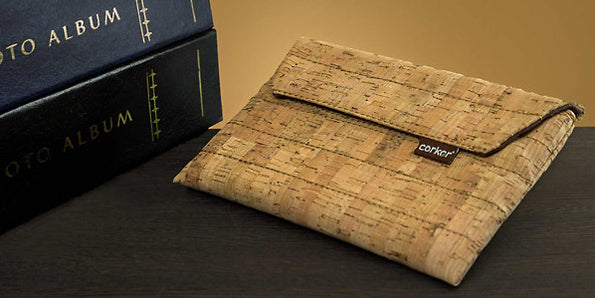
Timeless
- Ecological Materials
Corkor products are made with cork fabric, which is natural, veggie and a sustainable raw material.
Product lining are made with natural fabrics like cotton.
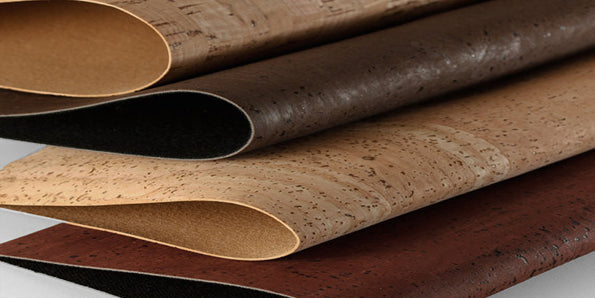
Cork Fabric - Natural, Vegan and Sustainable
- Paper Packaging
Corkor uses Kraft paper for packaging that is 100% natural and biodegradable.
Sewing paper! Yes, we sew every single paper bag in order to avoid using glue or tapes.
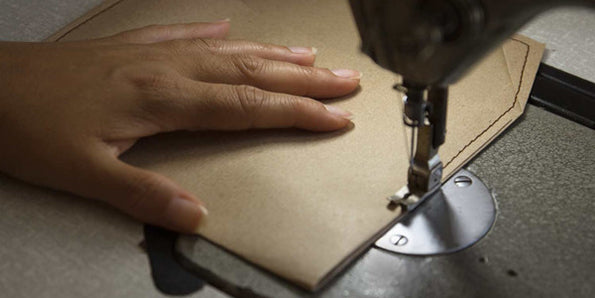
Paper Packaging
- Quality over quantity
Corkor products are handcrafted according to the traditions of experienced cork craftsmen in Portugal.
Love and detail goes into our work and great care is taken in selecting the best quality materials.
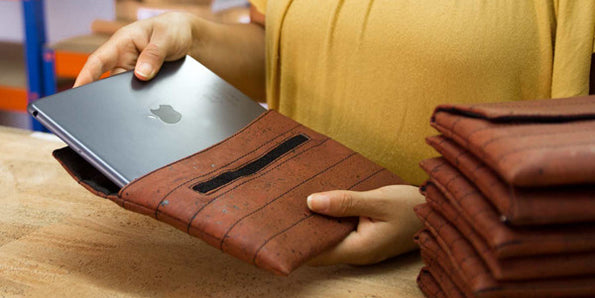
Quality over quantity
- Transportation
We are able to minimize all the transportation process by sourcing materials nearby, as cork is produced, extracted and transformed locally, in Portugal.
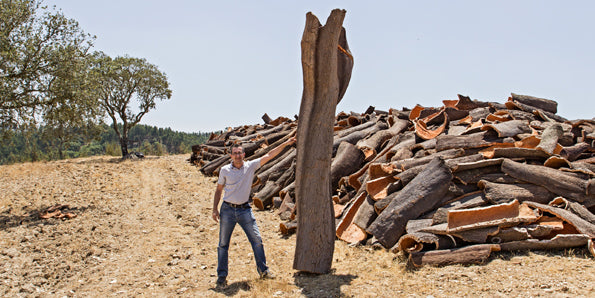
Sourcing material locally at a Portuguese Montado
- Ethical Production
Corkor products are locally handcrafted, using mainly sewing machines for a premium finishing by local workers that are fairly paid.
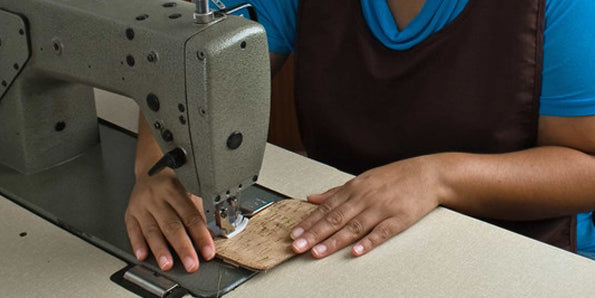
Machine sewing for a premium finishing
The importance of choosing cork stoppers
Maybe there isn't that big a difference between a cork stopper and a screw cap or plastic stopper if you are evaluating only the flavor of the wine. Specially if you are talking about new wines.
However, in the modern days, choosing eco-friendly and sustainable products is urgent.
The death of the cork industry will mean, without a doubt, the death of the montados and of all its endemic species.

















